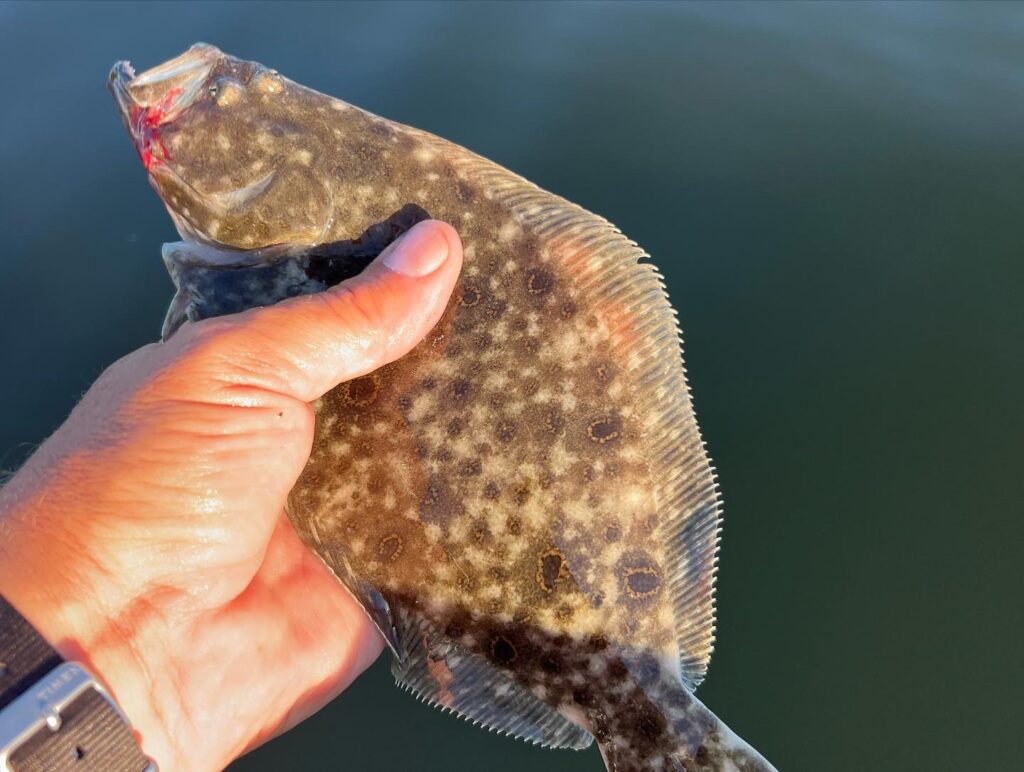Floundering around the Chesapeake Bay

By Dennis Doyle
The summer flounder is one of the most challenging and best-eating fish in the Atlantic, as well as the Chesapeake. Angling for them has only one drawback. Ardent flounder addicts rarely divulge the particulars of their conquests, especially the location, so reliable information is thin.
Another aspect of chasing this species is that it is rarely caught when fishing for other species. If you’re not rigged and fishing specifically for flounder, you probably won’t catch any.
First off, the summer flounder or fluke is an unusual fish. Born in the ocean from October through January, like any other fingerling they have eyes on either side of their head. As the fish grows though, it begins to favor swimming with its right side down. The eye on that side eventually migrates up and over to the left side of the fish’s head. The bottom side takes on a distinctly white color while the upper becomes a mottled dark olive and the species is then described as a flatfish.
Armed with a mouthful of sharp cutting teeth the flounder cruises the bottom of the water column, often burying itself in the sand or silt with only its eyes projecting so it can ambush passing prey, which includes small fish of all species, squid, crabs, worms, and shrimp. It is encountered in numbers along the Atlantic coast from Nova Scotia to Florida and often well up into the Chesapeake.
They are migratory and this year they have been reported as far as north of the Bay Bridge and in decent numbers of keeper-sized (16-inch minimum, possession limit four fish) in depths from 6 feet to 40. They can live 20 years or more and grow to over 30 inches, but a fish in the 20s is generally considered a trophy.
The species favors a sandy bottom and moving water as it prefers its prey to come to them rather than chase it, though it will attack a bouncing jig. Thomas Point, Love Point, Hackett’s Point, Tolley, Poplar Island, and Love Point as well as the mouth of the Choptank have been mentioned as producing for dedicated anglers, usually in 8 to 20 feet of water.
The favored rigs involve a one-ounce jig, white, yellow, or chartreuse, tipped with a 3-inch Berkley Gulp Curly Tail Grubs or minnows in similar colors on an 18-inch fluorocarbon leader coupled with another slightly lighter jig on a 12-inch leader. These duplex rigs catch markedly more fish than any other setup.
Drifted with the tide and jigged over the bottom, a careful watch must be placed on the baits as the strike is most often intended to stun or disable the prey and then the fluke will return to pick it up. Upon the strike the bait should be dropped back and allowed to quiver, almost motionless, awaiting the final take. Trolling can be effective but be certain the flounder is hooked up before picking up the rods—you may get numerous strikes before an actual hookup occurs.
Anchoring, casting and retrieving near structures such as bridge supports, lighthouses, pilings, and docks with soft paddle tail jigs bounced slow and deep can also produce. I’ve drifted small, live spot with excellent results in rips and current seams and drifting down drop-offs on falling tides. Unfortunately, flounder, as they hug the bottom closely, do not show up on fish finders so one has to operate on faith and high hopes until hitting success.
A net for landing is essential as solid hookups often don’t occur as their mouths are situated sideways. Also, keep in mind that this is one species that can swim backward so don’t be too casual with your net movements—lots of trophies are lost boat side.
If you are not experienced, refer to instructional videos before cleaning these flat-sided delectables as the technique is important. The bottom fillet is taken in two pieces and the top in one. A sharp, flexible, long blade (9-inch) can be handy, and a flat surface to work on and a steady hand are essential. There are few fish as delicious as this one.
